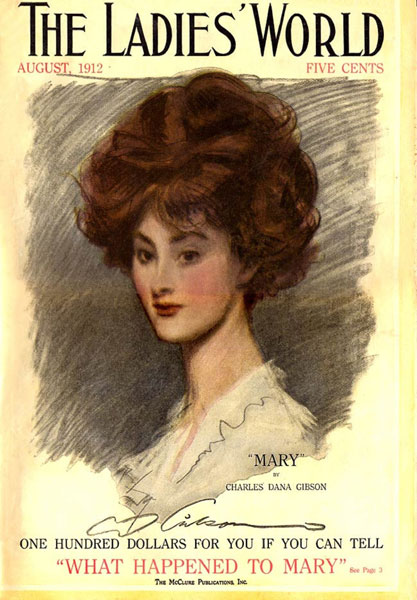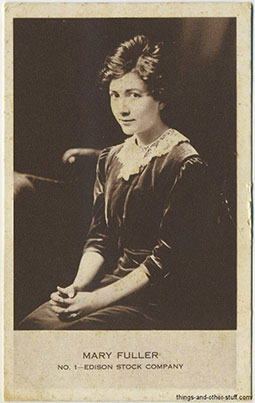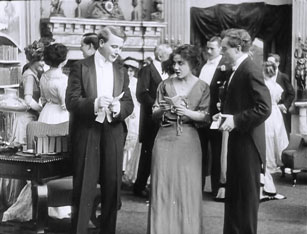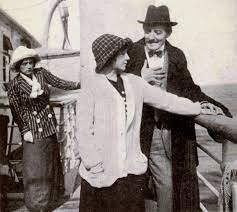W …is for
What Happened to Mary
Edison’s production had its genesis in a “remarkable story of a remarkable girl” published in early 1912 in McClure’s The Ladies’ World magazine, one of the most widely-read periodicals of its day, in which an abandoned baby named Mary is found by shopkeeper Billy Peart. In the basket beside Mary is five hundred dollars to raise her, along with a note promising Peart another thousand if he finds her a suitable husband when she comes of age. Years pass. But after Peart locates a likely candidate, the now-eighteen-year-old Mary rejects him. Having learned the curious circumstances of her “adoption,” she leaves town in search of the truth about her origins.
Similar series followed, among them Kalem’s railroad adventure The Hazards of Helen (1914-1917) and The Ventures of Marguerite (1915), which starred Marguerite Courtot as a young heiress who attempts to escape the many schemers, foreign agents, and kidnappers who want to steal her fortune—one of the most common plot lines in early series and serial pictures. As a precursor of the serial craze, though, What Happened to Mary continues to hold a distinctive and unparalleled place in silent and serial cinema history.
Survival Status: Uncertain. Progressive Silent Movie List writes that a print survives but does not indicate where. Other sources, however, suggest that the series is presumed lost.
Director: Charles Brabin (and possibly, according to Progressive Silent Movie List, others as well: J. Searle Dawley, Walter Edwin, George A. Lessey, Ashley Miller, and Harold M. Shaw)
Release Date: July 26, 1912
Release Company: Thomas A. Edison, Inc., distributed by the General Film Company, Inc.
Cast: Mary Fuller (Mary Dangerfield), William Wadsworth (Billy Peart), Ben Wilson, Marc MacDermott (Lt. Straker), Charles Ogle (Richard Craig, Mary’s Uncle), Barry O’Moore (Henry, Craig’s Son), Bliss Milford (Daisy), Bigelow Cooper (Mr. Foster, the Lawyer), Miriam Nesbitt (Spy), Harold M. Shaw (Rev. Cooper), Harry B. Eytinge (Secretary, Occidental Trust Company), Walter Edwin (Manager of Society Queen), Yale Benner (John Chase), James Smith (Stage Manager), Carey Lee (Leading Lady), Arthur Housman (Principal Comedian).
Episodes: (one reel each) 1. The Escape From Bondage. 2. Alone in New York. 3. Mary in Stageland. 4. The Affair at Raynor’s. 5. A Letter to the Princess. 6. A Clue to Her Parentage. 7. False to Their Trust. 8. A Will and a Way. 9. A Way to the Underworld. 10. The High Tide of Misfortune. 11. A Race to New York. 12. Fortune Smiles.
Who Will Marry Mary? (sequel to What Happened to Mary)
Survival Status: According to the Progressive Silent Film List, the film is presumed lost. But fragments of a single episode exist in the EYE Film Instituut Nederland Film Archive and the film holdings of Keene State College (New Hampshire). Access a portion of “A Proposal from the Duke” on YouTube at https://www.youtube.com/watch?v=xea6CGYjwp0.
Director: Unknown (possibly Walter Edwin)
Release Date: July 26, 1913
Release Company: Thomas A. Edison, Inc., distributed by the General Film Company, Inc.
Cast: Mary Fuller (Mary), Ben F. Wilson (Captain Justin Bradford), Richard Tucker (Duke Leonardo de Ferrara), William Wadsworth, Harry Beaumont, Miriam Nesbitt, Marc McDermott, Harold M. Shaw, May Abbey, Frank McGlynn, Sr., Walter Edwin, Pal (Dog).
Episodes: (one reel each) 1. A Proposal from the Duke. 2. A Proposal from the Spanish Don. 3. A Proposal from the Sculptor. 4. A Proposal from Nobody. 5. A Proposal Deferred. 6. A Proposal from Mary.





